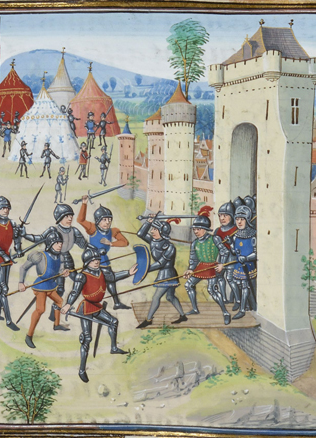Burning the Dead in the Grand Duchy of Lithuania in the 14th century
Do You Know?
Up until the official Christening of Lithuania in 1387, the custom of burning the dead prevailed in the Baltic territory. Cremation was not prevalent merely in the lands accommodated by the Samogitians and Semigallians. By that time, the Baltic tribes had been living surrounded by the Christian states for more than a century. As a result, urban polyethnic communities of a new type were being established, the views on afterlife of which were to a large extent influenced by the Christian neighbours.
The last Pagans
Historical sources recorded by the contemporaries testify of a deeply embedded practice of burning the deceased among the Prussians and Curonians. The earliest surviving message testifying the burning of the diseased Balts was recorded in the report by the English traveller about his journey through Prussia (890–893). The report provides information on the funeral rites and the practice of cremating the dead. Wulfstan highlights the differences in burial traditions based on the social layer.
According to him, “the kings and other persons of high social stature are kept not buried for a certain period of time, which depends on their wealth. The richer they are, the longer they remain unburied…”
Yet another message of cremating the dead is recorded in a later source, namely in the Peace Treaty concluded by the German Order with the Prussians in 1249. Adhering to the Treaty, the Prussians renounced the burial rite of burning the deceased persons. An allusion to this practice can also be found in the Livonian Rhymed Chronicle, in a description of how the Prussian tribe of Semba behaved after an unsuccessful military campaign (1254): “….Following their pagan priest‘s instructions, they quickly piled the corpses of the dead Prussians in a heap and set fire to them, to cremate the bodies of the deceased warriors.” The Curonians behaved in a similar manner during military campaigns. There is a description of the cremation ritual in the Livonian Chronicle of Henry (Henricus Lettus): after a failed siege of Turaida castle, defended by the Lyvian commander Kaupas, subordinate to the Order (1211), the Curonians “after gathering the corpses of their dead warriors, taking them to the ships and then crossing the Daugava river, rested for three days, burying the dead and lamenting their deaths and going into deep mourning.” In 1414, after Lithuania had accepted baptism, the French noble Ghillebert de Lannoy was travelling through the Curonian land Neringa, destined for Livonia. The Frenchman was the last witness to testify the custom of burning the bodies at death not only among the Balts but also among Europeans. In the part of the travel description dedicated to Curonian burial customs he stated that it was no longer a universally accepted practice: “There is one sect of the old Curonians, although there are forced converters to Christianity among them, the members of which are buried in the neighbouring forest or pinewood, clad in their best attire and adorned with the best weapons, instead of being buried, as for the custom for Christians.” The author gives an additional insight into the Curonian way of life. According to him, part of the Curonian community followed the cremation custom for a longer time. It is hard to know what Ghillebert de Lannoy had in mind referring to “one sect.” It is highly likely that he referred to military representatives rather than a family or tribe nurturing the old traditions. It is highly probable that with the spread of Christianity double burial customs existed for a certain time in other Baltic tribes as well.
Kings’ fire
Another type of contemporary sources provides information on the cremation custom in the eastern part of Baltic territory. There are no historical data testifying that such a custom was universally accepted on this territory. It is only in the Hypathian Codex that the baptism of King Mindaugas was mentioned. Most likely in the attempt to discredit King Mindaugas, the author of the Chronicle states that “his baptism was deceptive, (…) since he made offerings to his own Gods, burned the bodies of the dead and publicly confessed his own paganism.” The other three sources provide testimony about the funeral of the Grand Dukes Gediminas (Vytenis?), Algirdas and Kęstutis. Philippe de Mézières, the author of the allegorical voyage “A Dream of the Old Pilgrim” (Songe du Vieil Pèlerin), visited Prussia in 1364. He describes the funeral of Lithuanian ruler as follows: “the King, dressed in armour and seated on a steed as if he were alive, was burnt together with his best friend”. The Let (Lithuanian) King referred to in the text is believed to have been Gediminas or Vytenis. More information about the funeral of Grand Duke Algirdas (1377) is provided in the Livonian chronicle by Hermann von Wartberge, during which “following their custom, various things and eighteen steeds were burnt”. In the New Chronicle of Prussia by Wigand of Marburg, the following mention is given of Kęstutis funeral: “He was taken to Vilnius, where his body was burnt. (…) Horses, clothes, weapons, etc., everything was burnt, even the hunting birds and dogs were burnt together with the King’s body.” This is the only contemporary source testifying that the bodies of Grand Dukes of Lithuania were burnt and buried in Vilnius. Having found the dead body of his uncle in Krevo castle, Skirgaila took it all the way to Vilnius for cremation and burial ceremony. The tradition to burn and bury the Dukes in Vilnius is embodied in the legend of the legendary duke Šventaragis, recorded in the annals of later times. This is the description found in Maciej Stryjkowski’s Chronicle: “…he requested, or rather, ordered his son Germantas to burn the body after his death, following the pagan burial custom; he also gave orders that from that time onwards, the bodies of other Lithuanian Dukes, lords and more significant noblemen should be burnt and the burial ceremony conducted namely in that place and nowhere else, unlike the custom observed on the past, when the bodies of deceased persons were burnt in the place of death.”
Thus, it can be concluded that this might be a reference to a religious reform introduced in Lithuania at the beginning of historical times, when the cult of burning the bodies became a prerogative of the ruling elite.
Naturally, this reform will remain just a legend. However, it explains a historical puzzle of graves dated 13th-14h century, in which buried but unburned bodies were identified. Such graves were unearthed by archaeologists in Kernavė, Verkiai near Vilnius and other funerary monuments of Eastern Lithuania.
Do You Know?
Therefore, the ages old custom of burning the bodies of deceased Balts was fading away and this process lasted at least a century. The bodies of the Lithuanian Dukes and nobles had been burnt until Lithuania‘s official Christening, whereas provincial communities (e.g., Curonians) kept observing this custom for a much longer period, surprising travellers as late as the beginning of the 15th century, when Martin Luther, whose teachings inspired the Protestant Reformation movement, was devising his 95 famous theses.
Gintautas Vėlius


